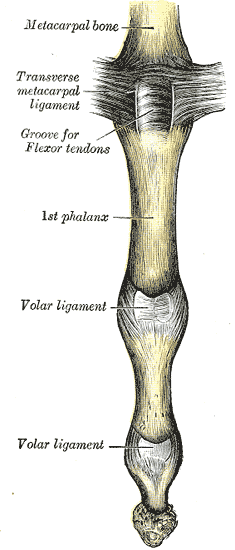Interphalangeal joints of the hand
Interphalangeal joints of the hand are the hinge joints located between the phalanges of the human hand. The interphalangeal joints are all hinge joints, a type of synovial joint that allows motion in one plane only.
Etymology[edit | edit source]
The term "interphalangeal" comes from "inter-", a prefix meaning "between", and "phalangeal", which pertains to the phalanges (the bones of the fingers and toes).
Anatomy[edit | edit source]
The interphalangeal joints of the hand are divided into two categories: the proximal interphalangeal joints (PIPs) and the distal interphalangeal joints (DIPs). The PIPs are the joints in the middle knuckles of the fingers, while the DIPs are the joints closest to the end of the fingers.
Each interphalangeal joint is surrounded by a joint capsule, and the bones that form the joint are covered by articular cartilage.
Function[edit | edit source]
The interphalangeal joints of the hand allow for flexion and extension of the fingers, which is essential for many tasks involving the hands.
Clinical significance[edit | edit source]
Conditions that can affect the interphalangeal joints of the hand include osteoarthritis, rheumatoid arthritis, and psoriatic arthritis. These conditions can cause pain, stiffness, and reduced function in the joints.
Related terms[edit | edit source]
Search WikiMD
Ad.Tired of being Overweight? Try W8MD's physician weight loss program.
Semaglutide (Ozempic / Wegovy and Tirzepatide (Mounjaro / Zepbound) available.
Advertise on WikiMD
|
WikiMD's Wellness Encyclopedia |
| Let Food Be Thy Medicine Medicine Thy Food - Hippocrates |
Translate this page: - East Asian
中文,
日本,
한국어,
South Asian
हिन्दी,
தமிழ்,
తెలుగు,
Urdu,
ಕನ್ನಡ,
Southeast Asian
Indonesian,
Vietnamese,
Thai,
မြန်မာဘာသာ,
বাংলা
European
español,
Deutsch,
français,
Greek,
português do Brasil,
polski,
română,
русский,
Nederlands,
norsk,
svenska,
suomi,
Italian
Middle Eastern & African
عربى,
Turkish,
Persian,
Hebrew,
Afrikaans,
isiZulu,
Kiswahili,
Other
Bulgarian,
Hungarian,
Czech,
Swedish,
മലയാളം,
मराठी,
ਪੰਜਾਬੀ,
ગુજરાતી,
Portuguese,
Ukrainian
Medical Disclaimer: WikiMD is not a substitute for professional medical advice. The information on WikiMD is provided as an information resource only, may be incorrect, outdated or misleading, and is not to be used or relied on for any diagnostic or treatment purposes. Please consult your health care provider before making any healthcare decisions or for guidance about a specific medical condition. WikiMD expressly disclaims responsibility, and shall have no liability, for any damages, loss, injury, or liability whatsoever suffered as a result of your reliance on the information contained in this site. By visiting this site you agree to the foregoing terms and conditions, which may from time to time be changed or supplemented by WikiMD. If you do not agree to the foregoing terms and conditions, you should not enter or use this site. See full disclaimer.
Credits:Most images are courtesy of Wikimedia commons, and templates, categories Wikipedia, licensed under CC BY SA or similar.
Contributors: Prab R. Tumpati, MD




